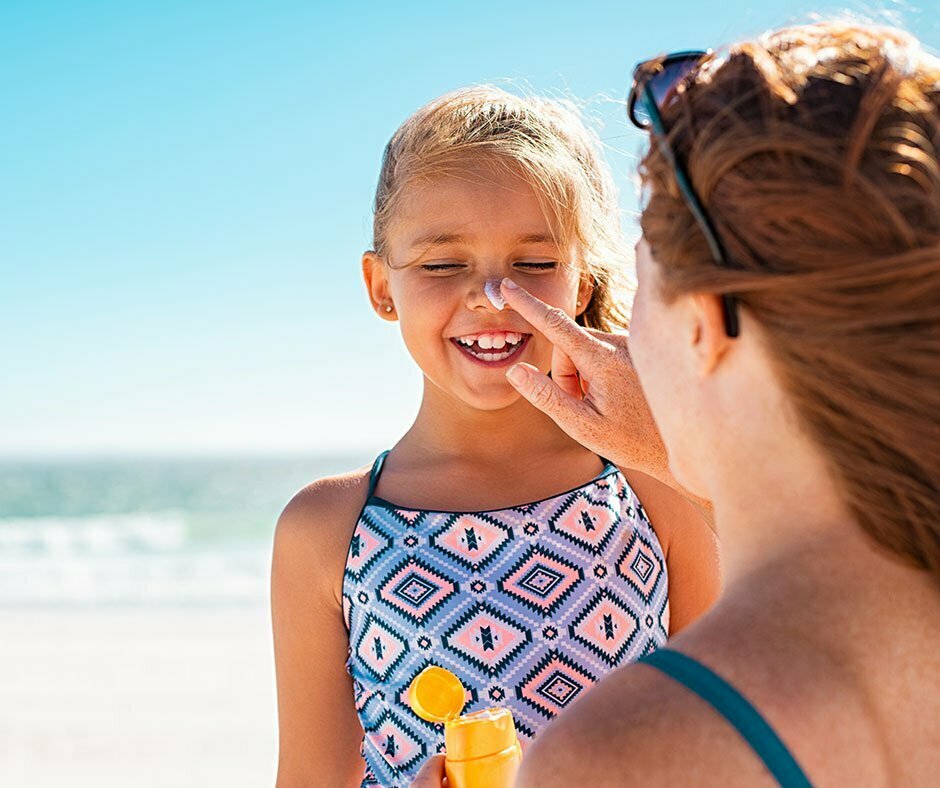Our relationship with the sun in Canada is definitely of the love-hate type! We miss it 6 months a year when we’re buried under snow or rain, and then, when it comes back out in May, we greet it with open arms… but no sunscreen!
Problem is, this particularity of our climate affects the reactivity of our skin to the attacks of the sun’s UV rays, and for us, the tan is not a sign of health, but rather of skin damage.
Let me explain. First, the sun sends us UVB rays that further assault our epidermis and cause sunburns; then UVAs that penetrate as deep as the dermis through clothes and car windows, to cause melanomas and premature aging of the skin; and finally, infrared (IR) radiation, which accelerates skin aging.
The radiation that causes a permanent tan, or a “delayed” tan, since it takes 48 hours to appear, is UVB.  Why does this process take 48 hours? As you can see in the illustration, UVB rays penetrate the skin as deep as the melanocytes, our little melanin factories, and excite them so that they start to produce our protective pigment, but the uniform distribution of melanin, like little parasols above the cell nuclei, takes almost 2 days. So be patient when you start on your holidays, because you can’t go faster than the metabolism of your cells! When I hear, “It’s no big thing if I get a sunburn, because afterwards, I’ll tan…” Well, it’s true, but it’s already too late. The damage to the skin cell nuclei is already done and, if the immune system doesn’t respond to this anomaly, several years later, a melanoma-type skin cancer might develop. A single cell damaged in childhood is enough to cause severe repercussions in adults… and if you can imagine, I still hear that sunscreens cause cancers! With this kind of thinking, we find ourselves ranking second for countries with the most cases of skin cancer in the world.
Why does this process take 48 hours? As you can see in the illustration, UVB rays penetrate the skin as deep as the melanocytes, our little melanin factories, and excite them so that they start to produce our protective pigment, but the uniform distribution of melanin, like little parasols above the cell nuclei, takes almost 2 days. So be patient when you start on your holidays, because you can’t go faster than the metabolism of your cells! When I hear, “It’s no big thing if I get a sunburn, because afterwards, I’ll tan…” Well, it’s true, but it’s already too late. The damage to the skin cell nuclei is already done and, if the immune system doesn’t respond to this anomaly, several years later, a melanoma-type skin cancer might develop. A single cell damaged in childhood is enough to cause severe repercussions in adults… and if you can imagine, I still hear that sunscreens cause cancers! With this kind of thinking, we find ourselves ranking second for countries with the most cases of skin cancer in the world.
This erythema phenomenon, or redness of the skin when exposed to UVB radiation, is the basis of sunscreen SPF calculations. Not only does it represent the cream’s protection against UVBs, but also the percentage of protection of this cream on the skin. This has nothing to do with the duration in minutes or hours, as an SPF 15 cream with organic filters protects for more than 15 minutes, and an SPF 100 does not protect for only 100 minutes. If they are used and applied as per instructions, they will protect for the required 2 hours and with an efficiency of 98%. Be careful not to feel over-protected when using a sun protection with such a high SPF, and remember that it does not cover much more than an SPF 45 cream and that it’s important to re-apply just as often!
That’s why it’s so important to buy and correctly apply a sunscreen that will protect you against such permanent damage. But how should you choose your sun cream? Not an easy question. There are so many on the market, and over the last few years, the trend has shifted to sunscreens containing 100% mineral filters. But beware: this is just a trend, and simply because development costs are much lower than for organic sunscreens, not because they’re better for the skin! For some, this means a whitish cream that’s hard to apply in certain cases. Rest assured, by the end of this article, you will understand how mineral filters work, and how they differ from organic filters.
Let’s start with the easiest: the only 2 mineral filters approved for the Canadian market are titanium dioxide (TiO2), which provides very good UVB protection, but limited UVA protection, and zinc oxide (ZnO), which covers the entire spectrum of UVB and UVA radiation (broad spectrum). Mineral filters work like tiny mirrors, i.e. they will reflect solar radiation so that it is not absorbed by skin cells, much like a second skin! These are the only 2 filters approved for the organic (ECOCERT) sunscreen market.
It is however important to mention that TiO2 has a photoprotection capacity almost 4 times higher than  ZnO, so if you’re looking for a high-SFP sun protection, make sure that both mineral filters are present in your cream. This will ensure you get very good broad spectrum protection against all UVBs and UVAs, and so the company can feature the new UVA logo (effective since 2014), which means you are well protected against radiation causing the most dangerous skin cancers.
ZnO, so if you’re looking for a high-SFP sun protection, make sure that both mineral filters are present in your cream. This will ensure you get very good broad spectrum protection against all UVBs and UVAs, and so the company can feature the new UVA logo (effective since 2014), which means you are well protected against radiation causing the most dangerous skin cancers.
In the case of mineral sunscreens, getting the right texture for easy application has always been a major challenge for cosmetics companies. The reason is simple: the larger the particles of these filters, the more the cream will be white and thick. Fortunately, we’ve seen considerable improvement with the arrival of smaller (nanoparticles), and sometime, tinted filters. So we can now find 100% mineral sun creams that are both lighter and easier to apply, and even offer a BB cream effect for tinted facial sunscreens. For those who worry about the potential risk of nanoparticles in these solar products, rest at ease: current studies have confirmed that these filters do not penetrate the skin. However, it is recommended to avoid inhaling them, so stay away from highly volatile aerosols. Another, very interesting fact about mineral sunscreens is that they are often formulated based on Aloe vera instead of water, which makes the cream nourishing and soothing, as well as protective. Note also that 100% mineral sun protection have better water resistance, such as 80 minutes in most cases, so they’re ideal for babies’ and children’s skin and sensitive skins too. They would, supposedly, have a more positive impact on the environment, although the current results of research teams working on this subject are not very conclusive.
Now, let’s talk about organic sunscreens (formerly called chemical filters), which work very differently. When correctly applied on the skin surface, preferably 15 minutes before exposure for better positioning in the cornified layer, they act as little sponges that absorb solar radiation instead of the living skin cells. This phenomenon tells us when to re-apply sunscreen since, after 2 hours, “the sponge is full” and no longer capable of absorbing UVs instead of our skin. Currently, 19 organic filters are approved by Health Canada. Unfortunately, I can’t name them all, but you will find all the details in the sunscreen monographs on the Health Canada website. To find the best organic-filter sunscreens on the market, each year, the Canadian Dermatology Association publishes a list of names of recommended solar products. Some organic filters have UVB protection, others have UVA protection, so this category of solar care uses a synergy of several organic filters to cover the entire spectrum of solar radiation. They must be photostable, in sufficient concentrations and, especially, safe for the skin. Based on photoprotection criteria, but mostly on skin tolerance, dermatologists will recommend sunscreens containing either Mexoryl XL and SX or Tinosorb M and S.
Don’t forget to re-apply a sufficient amount of sun cream every 2 hours or after each swim, intense physical activity, or rubbing of areas exposed to the sun, no matter what SPF you’re using! Because, as we said earlier, an SPF 100 sunscreen will not protect you any longer than an SPF 50. That’s why Health Canada fell into step with the European Union with regards to the SPF mention, which is now limited to 50+. It is also important to follow the expiration dates on containers and to discard any solar products OPEN for 12 months. This is because an organic-filter SPF 60 sunscreen bought last summer will only provide SPF 30 protection this year. And with mineral sunscreens, the cream (emulsion) itself will age and no longer efficiently maintain a uniform suspension of the mineral filters, which are heavier!
activity, or rubbing of areas exposed to the sun, no matter what SPF you’re using! Because, as we said earlier, an SPF 100 sunscreen will not protect you any longer than an SPF 50. That’s why Health Canada fell into step with the European Union with regards to the SPF mention, which is now limited to 50+. It is also important to follow the expiration dates on containers and to discard any solar products OPEN for 12 months. This is because an organic-filter SPF 60 sunscreen bought last summer will only provide SPF 30 protection this year. And with mineral sunscreens, the cream (emulsion) itself will age and no longer efficiently maintain a uniform suspension of the mineral filters, which are heavier!
Sun creams are much more than filters, they must remain stable with time, in extreme heat, with a uniform distribution of filters in the product, but they must also contain antioxidants and/or antiradicals to counter the damage caused by the few rays that will penetrate the protection barrier of your cream. UVs on the skin surface cause the creation of free radicals which also damage cells by triggering inflammatory reactions, which also cause sunburns.
And finally, don’t forget it’s possible to tan with a high-SPF sun cream; the tan will be more progressive, more uniform, and longer-lasting, because, let’s face it: “Your Skin, the only piece of Clothing you will Wear your whole Life!™”

